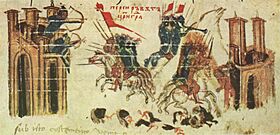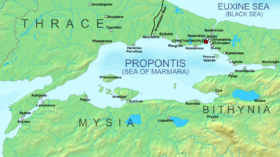Siege of Constantinople (626) facts for kids
Quick facts for kids Avar–Persian siege of Constantinople |
|||||||||
|---|---|---|---|---|---|---|---|---|---|
| Part of Byzantine–Sasanian War of 602–628 and the Avar–Byzantine Wars | |||||||||
 A picture of the siege from an old book called the Chronicle of Constantine Manasses |
|||||||||
|
|||||||||
| Belligerents | |||||||||
Avar Khaganate Sclaveni |
|||||||||
| Commanders and leaders | |||||||||
| Bayan III |
Patriarch Sergius Magister Bonus Theodore |
||||||||
| Strength | |||||||||
| About 80,000 soldiers | Less than 8,000 soldiers, outnumbered 10 to 1 | ||||||||
The siege of Constantinople in 626 was a major battle where the city of Constantinople was attacked. It was fought by the Persians and the Avars, who were helped by many Slavic allies. The city was defended by the Byzantines.
This siege ended with a big win for the Byzantines. Their victory was very important because it stopped their empire from falling apart. This win, along with other successes by Emperor Heraclius in 625 and 627, helped the Byzantines get back their lands. It also ended the long and damaging Roman–Persian Wars, bringing peace with the same borders as before.
Contents
Why the Siege Happened
In 602, a man named Phocas took over as emperor, replacing Emperor Maurice. Old writings say that Phocas was a bad ruler and made many mistakes. His poor leadership made the Byzantine Empire weak.
This weakness allowed the Persian king Khosrau II to attack. He used the change in emperors as an excuse for war. Khosrau II had been friends with Emperor Maurice, who had helped him get his throne back earlier.
At first, the Persian invasion went well. The Byzantines were pushed back into their own land, called Anatolia. Later, Phocas was removed from power by Heraclius. Heraclius started to fight back, even leading his army himself.
However, the situation got worse for the Byzantines. They lost all their lands in the Near East, including Egypt. Even though Heraclius tried to attack Persia several times, he could not stop his enemies. The Persians eventually reached his capital city, Constantinople. They set up their camp in Chalcedon, just across the water from Constantinople, and prepared to attack.
The Siege Begins
King Khosrau of Persia realized he needed a big attack to defeat the Byzantines. He gathered two new armies, including many foreign fighters. One army, with 50,000 men, stayed in Mesopotamia and Armenia. Their job was to stop Emperor Heraclius from invading Persia.
A smaller Persian army, led by Shahrbaraz, secretly moved around Heraclius's forces. They went straight for Chalcedon, which was across the Bosphorus strait from Constantinople. Khosrau also worked with the leader of the Avars to plan a joint attack. They wanted to hit Constantinople from both the European and Asian sides at the same time.
The Persian army set up camp at Chalcedon. The Avars positioned themselves on the European side of Constantinople. They likely destroyed the Aqueduct of Valens, which brought water to the city.
However, the Byzantine navy controlled the Bosphorus strait. This meant the Persians could not send their soldiers across the water to help the Avars. This made the siege less effective. The Persians were very good at attacking cities, but they couldn't get their equipment to the European side. Also, the Persians and Avars found it hard to talk to each other across the guarded Bosphorus.
Defending the City
The defense of Constantinople was led by Patriarch Sergius and a high-ranking official named Bonus. When Emperor Heraclius heard about the siege, he divided his army into three parts. He believed the capital was fairly safe, but he still sent some soldiers to Constantinople. This was to encourage the defenders.
Another part of his army, led by his brother Theodore, went to fight the Persian general Shahin. The third and smallest part of the army stayed with Heraclius. He planned to attack the heartland of Persia.
On June 29, 626, the Avars and Persians launched a big attack on the city walls. Inside Constantinople, about 12,000 skilled Byzantine cavalry soldiers defended the city. They were likely fighting on foot. They faced about 80,000 Avars and Slavs. These attackers wanted to remove all Roman rule from Europe.
The Avars started moving heavy siege machines towards the Theodosian Walls. This made it clear they planned a full siege. Even though the city was bombed for a month, the people inside Constantinople felt strong. This was thanks to Patriarch Sergius's religious passion. He walked along the walls with an important religious picture, possibly of the Virgin Mary. This made people believe that God was protecting the Byzantines.
The Patriarch also encouraged the farmers around Constantinople to be very religious. This was even more effective because they were fighting against people who were not Christians. Because of this, every attack by the enemy failed.
Turning the Tide
The attackers panicked when the Avar-Slavic fleet and the Persian fleet were sunk in two different sea battles. They fled, giving up the siege. They seemed to believe that God had helped the Byzantines win.
On August 7, a group of Persian rafts carrying soldiers across the Bosphorus were surrounded. Byzantine ships destroyed them. At the same time, the Slavs, who were with the Avars, tried to attack the sea walls from the Golden Horn. The main Avar army attacked the land walls.
Patrician Bonus's warships crashed into and destroyed the Slavic boats. The Avar attack on land, from August 6 to 7, also failed. Then, news arrived that Theodore had won a big victory over the Persian general Shahin. It was even said that Shahin died from sadness after this defeat.
With this news, the Avars retreated to their lands in the Balkans within two days. They never seriously threatened Constantinople again. Even though the army of Shahrbaraz was still camped at Chalcedon, the danger to Constantinople was over. To thank the Virgin Mary for lifting the siege and for her supposed divine protection, a new hymn was written.
What Happened Next
The loss at the siege happened just after the Byzantines heard about another victory. Emperor Heraclius's brother Theodore had won a big battle against the Persian general Shahin. Also, the emperor showed Shahrbaraz some letters he had captured. These letters showed that King Khosrau had ordered Shahrbaraz's death. Because of this, Shahrbaraz switched sides and joined Heraclius.
Shahrbaraz then moved his army to northern Syria. From there, he could easily choose to support either Khosrau or Heraclius. By getting rid of Khosrau's most skilled general, Heraclius took away some of his enemy's best soldiers. This also made his own army safer before he invaded Persia.
The next year, Heraclius invaded Mesopotamia again. He defeated another Persian army at the Battle of Nineveh. After that, he marched to Ctesiphon, the Persian capital. There was a lot of chaos in Ctesiphon, with one Persian king being overthrown after another. This allowed Heraclius to demand even better peace terms.
In the end, the Persians had to pull all their soldiers out of the lands they had taken. They returned Egypt, the Levant, and all the Roman lands in Mesopotamia and Armenia that they had held. The war was over. Neither the Persians nor the Byzantines would fight each other again until the Arab-Islamic invasion weakened both empires.
Why the Siege Failed
The siege of Constantinople in 626 failed for several reasons. The Avars did not have enough patience or the right tools to conquer such a strong city. The Persians were very good at attacking cities, but the walls of Constantinople were too strong. The siege towers and machines could not break through them easily.
One big problem was that the Persians could not move their siege equipment to the European side of the Bosphorus. This side was heavily guarded, and their Avar and Slavic allies were there. Also, the Persians and Slavs did not have a strong enough navy in the Mediterranean Sea. This meant they could not ignore the sea walls or easily communicate with each other. The Avars eventually ran out of supplies, which made them give up the siege.
See also
- Bonus
- Byzantine-Sassanid Wars
- Siege of Constantinople (674)


